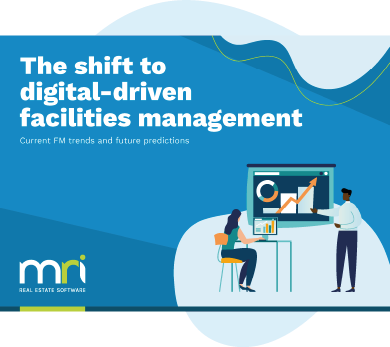What is a building management system?
What is a building management system and how can it help your building? At the core of modern real estate management, a building management system (BMS) marks a pivotal shift toward more integrated and intelligent building operations. From energy savings to enhanced operational efficiency, a BMS (often working hand-in-hand with an energy management system) transforms how buildings are managed, making them more sustainable, efficient, and occupant-friendly.
This post explores the multifaceted roles and capabilities of a these systems, while highlighting the significant facilities management software benefits you gain when implementing a BMS.
How do building management systems work?
Building management systems are at the heart of modern building efficiency. A BMS enables you to monitor and control a building’s various systems from a single, centralized interface. Essentially, a BMS integrates your building’s core operational systems – such as heating, ventilation, air conditioning (HVAC), lighting, and security – into one cohesive network. This integration enables complete management and oversight, ensuring that each system operates optimally and in sync with the others.
The core of a BMS is a powerful software platform that collects data from sensors and devices distributed throughout your building. These sensors monitor everything from temperature and light levels to occupancy and energy usage, providing a comprehensive overview of your building’s performance. The BMS software analyzes this data, enabling the solution to make real-time system setting adjustments to maintain optimal conditions and performance.
The true power of a BMS is its ability to automate routine tasks and respond to changing conditions without the need for manual intervention. For example, a BMS can adjust heating or cooling in response to external weather changes or modify lighting based on the time of day and occupancy levels. This automation not only ensures building systems operate efficiently. It also significantly reduces the workload on building managers so they can focus on other critical aspects of building operations.
What are the benefits of using a BMS?
Energy savings
A BMS is a cornerstone in creating substantial energy savings for building owners. By integrating and automating the control of energy-consuming systems such as HVAC and lighting, a BMS greatly optimizes energy use. This intelligent management ensures that energy is only used when and where it is needed, minimizing waste and reducing energy bills.
BMSs can adapt to the building’s real-time occupancy, adjusting systems to ensure optimal energy efficiency without compromising comfort. The solution’s ability to monitor and analyze energy usage data also enables more informed decision-making, identifying areas for improvement and further savings. This capability not only directly reduces operating costs but also contributes to the broader environmental sustainability goals.
Improved comfort
Building management systems significantly enhance the comfort of building environments for occupants. By intelligently controlling HVAC and lighting systems, a BMS ensures that indoor conditions are maintained at optimal levels. Whether it adjusts temperatures to suit the weather outside or ensures that lighting is just right for the time of day and activity within the building, a BMS caters to the comfort needs of all occupants. These adjustments create a more pleasant and productive environment, which is especially important in spaces like offices, residential buildings, and commercial venues.
A BMS’s ability to respond to changing conditions in real-time means that comfort is continuously managed without manual intervention. Whether adjusting for a crowded conference room or a vacant office, the system ensures that comfort is optimized as well as maintained. This attention to the well-being of occupants not only enhances their experience but also reflects positively on the building’s management, fostering satisfaction and loyalty.
Environmental impact
Building management systems are critical in reducing the environmental footprint of buildings. By optimizing the operation of HVAC, lighting, and other systems, a BMS ensures minimal energy consumption. Reduced energy use directly correlates to decreased greenhouse gas emissions, contributing to the global effort against climate change. Implementing a BMS is a proactive step towards sustainability, demonstrating a commitment to responsible environmental stewardship.
A BMS can contribute to better resource management and waste reduction. By providing detailed insights into energy consumption patterns, the solution enables building managers to identify areas where efficiency can be improved, leading to further environmental benefits. A BMS not only helps conserve precious resources, but also positions the building as a leader in sustainability efforts, appealing to tenants and stakeholders who value eco-friendly practices.
Facility management
Building management systems revolutionize facility management by offering a comprehensive platform for overseeing building operations. By centralizing control of various building systems like HVAC, lighting, security, and more, a BMS simplifies the management process, reducing the need for manual intervention and monitoring. This integration lets facility managers oversee all aspects of a building’s operations from a single point, enhancing efficiency and reducing the likelihood of oversight or errors.
A BMS facilitates proactive facility management. Through real-time monitoring and data analysis, the system can predict maintenance needs, identify inefficiencies, and suggest improvements. This enables facility managers to address issues before they escalate, ensuring the smooth operation of building systems and extending their lifespan. The result is not just a more efficiently managed facility but also significant cost savings over time, as the need for emergency repairs and downtime is drastically reduced.
Building management system FAQs
Facilities Management software
Leading solutions for property occupiers, owners and service providers & contractors.

Contact MRI Software
Ready to learn more about how MRI Software’s innovative software solutions can make your building management more efficient? Contact us today.
The shift to digital-driven Facilities Management
Introduction Historically, the success of the FM function was measured by its ability to keep things running behind the scenes. With new and urgent industry challenges bringing facilities management into the limelight, this is no longer the case. Fac…
